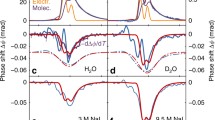Abstract
The transformation of molecular rotation with rise of the buffer gas pressure is studied. The evolution of the optically induced anisotropy is measured for perylene and 1,4-di[2-(5-phenyloxazolyl)]benzene (POPOP) in pentane at high pressures. The orientational relaxation is shown to be governed not only by the buffer gas pressure (which determines the collision frequency), but also by the efficiency of the collisional angular momentum transfer. The orientational relaxation of perylene falls in between the predictions of the strong (J diffusion) and weak (Fokker–Planck equation) collision models. The situation is found to be closer to the latter, and four collisions with pentane are approximately necessary for randomization of the perylene angular momentum. The orientational relaxation of POPOP in the vicinity of the critical liquid–gas point is demonstrated to be almost independent of the pentane pressure in the range 45–130 atm, which is a manifestation of rotational diffusion. Generally, it was found that perylene rotates more freely than POPOPdeed, under the pentane pressure of the order of 50 atm, the rotation of POPOP is highly damped and is described by the diffusion equation. On the other hand, the orientational relaxation of perylene under pentane pressures of about 100 atm exhibits characteristic features arising due to inertial effects.
Similar content being viewed by others
REFERENCES
A. I. Burshtein and S. I. Temkin, Spectroscopy of Molecular Rotations in Gases and Liquids, Cambridge University Press, Cambridge (1994).
A. B. Myers, M. A. Pereira, P. L. Holt, and R. M. Hochstrasser, J. Chem. Phys., 86, 5146-5155 (1986).
M. A. Pereira, P. E. Share, M. J. Sarisky, and R. M. Hochstrasser, J. Chem. Phys., 94, 2513-2522 (1991).
Y. Zhang, M. I. Sluch, M. M. Somoza, and M. A. Berg, J. Chem. Phys., 115, 4112-4231 (2001).
J. S. Baskin and A. H. Zewail, J. Phys. Chem. A, 105, 3680-3693 (2001).
N. A. Borisevich, E. V. Khoroshilov, I. V. Kryukov, A. V. Sharkov, A. P. Blokhin, and G. B. Tolstorozhev, Chem. Phys. Lett., 191, 225-231 (1992).
J. S. Baskin, M. Gupta, M. Chachisvilis, and A. H. Zewail, Chem. Phys. Lett., 275, 437-444 (1997).
J. S. Baskin, M. Chachisvilis, M. Gupta, and A. H. Zewail, J. Phys. Chem. A, 102, 4158-4171 (1998).
A. P. Blokhin, M. F. Gelin, O. V. Buganov, V. A. Dubovskii, S. A. Tikhomirov, and G. B. Tolstorozhev, Zh. Prikl. Spektrosk., 70, 66-72 (2003).
A. P. Blokhin and M. F. Gelin, Khim. Fiz., 16, 39-49; 50-59 (1997).
A. P. Blokhin and M. F. Gelin, Khim. Fiz., 13, No. 1, 14-20 (1994).
A. P. Blokhin and M. F. Gelin, J. Mol. Liq., 93, 47-50 (2001).
J. O'Dell and B. J. Berne, J. Chem. Phys., 63, 2376-2394 (1975).
M. F. Gelin, J. Phys. Chem. A, 104, 6150-6151 (2000).
N. A. Borisevich, S. P. Pliska, and V. A. Tolkachev, Dokl. Akad. Nauk SSSR, 261, No. 5, 1109-1114 (1986).
N. A. Borisevich, V. V. Gavrilyuk, V. A. Povedailo, and V. A. Tolkachev, Dokl. Akad. Nauk SSSR, 305, 1344-1346 (1989).
A. P. Blokhin and M. F. Gelin, Chem. Phys., 252, 323-335 (2000).
A. P. Blokhin and M. F. Gelin, Mol. Phys., 87, 455-468 (1996).
A. P. Blokhin, M. F. Gelin, I. I. Kalosha, V. V. Matylitsky, N. P. Erohin, M. V. Barashkov, and V. A. Tolkachev, Chem. Phys., 272, 69-76 (2001).
V. M. Zhdanov and M. Ya. Alievskii, Processes of Transport and Relaxation in Molecular Gases [in Russian], Moscow (1989).
M. P. Allen, G. T. Evans, D. Frenkel, and B. M. Mulder, Adv. Chem. Phys., 83, 89-121 (1993).
D. Chandler, J. Chem. Phys., 62, 1358-1363 (1975).
S. P. Pliska and V. A. Tolkachev, Zh. Prikl. Spektrosk., 50, No. 5, 47-50 (1989).
V. A. Gaisenok and A. M. Sarzhevskii, Anisotropy of Absorption and Luminescence of Polyatomic Molecules [in Russian], Minsk (1986).
J. Garcia de la Torre: Molecular Electro-Optics, Plenum, New York (1981).
L. D. Favro, Phys. Rev., 119, 53-62 (1960).
Author information
Authors and Affiliations
Rights and permissions
About this article
Cite this article
Blokhin, A.P., Gelin, M.F., Buganov, O.V. et al. Collisional Relaxation of the Optically Induced Dichroism of Complex Molecules in a Gas Phase. Journal of Applied Spectroscopy 70, 378–384 (2003). https://doi.org/10.1023/A:1025129404915
Issue Date:
DOI: https://doi.org/10.1023/A:1025129404915




